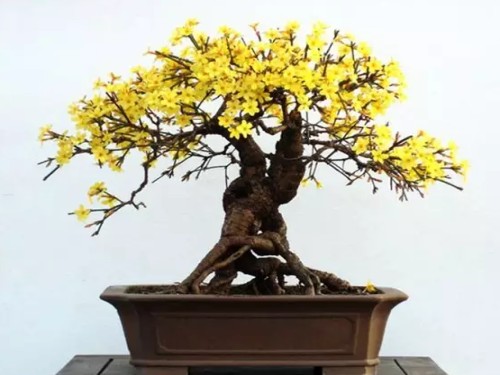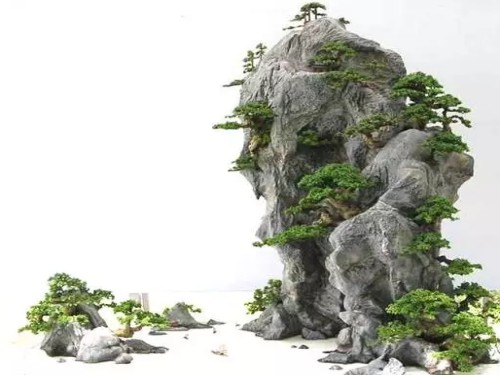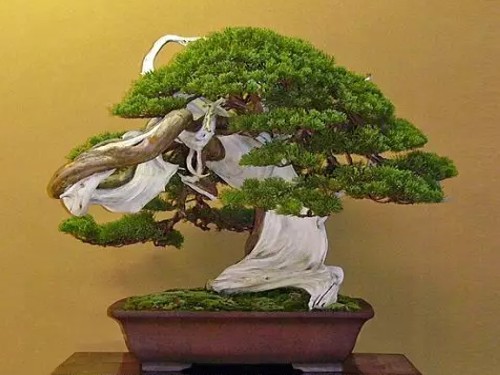Steps of making bonsai of primrose
Primrose has small and supple branches, well-developed root system, strong sprouting power, pruning resistance, golden green calyx, gorgeous and funny, so it is a good bonsai material. Primrose bonsai branches flat bend, green vines facing the wind, golden flowers according to the eyes, full of ancient interest. It is a good taste for ornamental flowers in cold winter and early spring. Moreover, the branches of primrose are sprouting and resistant to pruning, and they can be often trimmed and shaped to make them maintain a perfect posture to show to the world.
Primrose is not only dignified and beautiful in color, but also has the excellent quality of being not afraid of cold power. It is one of people's favorite plants. Next, let's take a look at the steps of making primrose bonsai.

1. Draw materials
The materials for making primrose bonsai are mainly artificial cultivation and excavation of stout old piles in the wild because of their resistance to pruning and strong sprouting power. The main purpose of field excavation is to protect the root, keep the intact root system as far as possible, remove the disabled and dead root system, straighten out the root system, plant it deeply in the pot, and gradually carry out root lifting.
2. Selection of basin
Primrose bonsai is generally appropriate to use deep color purple sand pottery or glazed pottery, according to the shape of primrose bonsai to determine the shape of the flowerpot. Cliff-style primrose bonsai can be used with a deep thousand-barrel basin, sometimes to highlight the beauty of the roots, but also to use a shallow basin. The color of the flowerpot should be those that set off the beauty of primrose yellow florets, such as dark blue, light blue, dark or purplish red.
3. Cultivation
After a stage of cultivation, the root system developed normally, and the whisker root grew in the cultured soil, which had deep roots and luxuriant leaves. At this time, you can gradually take out the fine sand, so that the upper roots are slowly exposed. After a certain period of training, the exposed roots have gradually aged, and the lateral roots are relatively stout, so the flowers and trees can be moved to the shallow basin. The root system should be fully protected and the original culture soil should be brought when transplanting. In this way, we can gradually cultivate a primrose bonsai with hanging roots and exposed claws, simple and vigorous.
4. Watering
Welcome spring like to be moist, especially in the hot summer, in addition to watering once every morning, it should also be properly watered in the afternoon. In order to maintain the humidity of the small environment, water should be sprayed to the ground frequently. Yingchun is afraid of stagnant water in the basin. During the rainy season, when it rains continuously, the basin should be put down or moved to a place free from rain. Low temperature in winter, less water evaporation, should be less watering.
5. Fertilization
When planting primrose bonsai, you should put a few pieces of animal hooves at the bottom of the bowl as base fertilizer. During the spring growing period, mature and thin liquid fertilizer should be applied once or twice a month. Spring flower bud differentiation period is from July to August, so liquid fertilizer with more phosphorus should be applied to facilitate the formation of flower buds. Such as in the early stage of flowering, the application of a rotten thin organic liquid fertilizer can make the flower color bright and prolong the flowering period.
6. Pruning
The branches should be re-cut and all the branches should be removed except the selected ones. Cut off the branches after digging up the primroses, because too many branches will die when the roots are damaged, the branches are too short and the buds are not easy to pull out, exposing 1/3 of the roots. Wait until they survive and look at the shape of the primroses and trim them properly. To control the growth of primrose branches, too long will affect the overall shape of the treatment. The preservation of branches should also be cut short, according to the growth characteristics of primrose, can be cultivated into cliff-type, semi-cliff-type bonsai.
7. Modeling
The branches of primrose droop as naturally as willows, and the roots have characteristics, so they are very suitable for processing into drooping branches and lifting roots. In the daily bonsai production, the above two bonsai models are often combined, the roots of primroses are exposed, and the trunk is made into horizontal dry type or curved dry type, twigs are brushed, with unique charm. Primrose bonsai can reshape the plant before flowering, and the heart is often picked during the growing period, in order to make the branches thicker and increase branches, which is conducive to modeling, and the branches that affect the tree shape should be cut off in time to maintain the beauty of the bonsai. After the shape is finalized, the excess branches and leaves should be cut and thinned every year to keep the tree shape unchanged.
8. Turn the basin
Yingchun generally turns the basin every two years, and the time should be after the leaves fall in spring or autumn. When turning the basin, it can be combined with pruning the root system, cutting off the withered root and overlong root, in order to facilitate the development of fibrous root. Bean cake crumbs can also be placed at the bottom of the basin as base fertilizer. If you need to lift the root to welcome the spring, you can lift the root properly when planting, and cover the soil around the root. In the future, with the leaching of watering, the root will be naturally exposed.
Time: 2019-05-26 Click:
- Prev

Production techniques of Landscape Bonsai
To make landscape bonsai, we must first carry out artistic conception, determine the theme, and then take all or part of the stone materials suitable for shape according to the natural temperament of the rocks, and carve them artificially with plants and necessary accessories, and configure them into rockery. Natural scenery such as Qifeng, Gaoxia Feiyang, Baizhang Qianfeng, Cave and other natural scenery
- Next

Techniques for making pine and cypress bonsai
Shandong is one of the birthplaces of ancient Chinese culture. On Mount Tai, the head of the five Mountains, there are various kinds of ancient pines on Mount Tai and Houshiwu; in the Zhongjun account ancient temple in Culai Mountain, there are ancient pines that are hundreds of years old; in the loan Temple in Tai'an, some people call the ancient cypress Linghan; in Lingyan Temple and Qufu Konglin, there are many ancient cypresses whose old branches have experienced Cangsang.
Related
- Fuxing push coffee new agricultural production and marketing class: lack of small-scale processing plants
- Jujube rice field leisure farm deep ploughing Yilan for five years to create a space for organic food and play
- Nongyu Farm-A trial of organic papaya for brave women with advanced technology
- Four points for attention in the prevention and control of diseases and insect pests of edible fungi
- How to add nutrient solution to Edible Fungi
- Is there any good way to control edible fungus mites?
- Open Inoculation Technology of Edible Fungi
- Is there any clever way to use fertilizer for edible fungus in winter?
- What agents are used to kill the pathogens of edible fungi in the mushroom shed?
- Rapid drying of Edible Fungi

